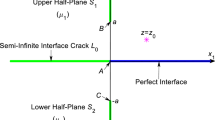Abstract
Using dislocation simulation approach, the basic equation for a finite crack perpendicular to and terminating at a bimaterial interface is formulated. A novel expansion method is proposed for solving the problem. The complete solution to the problem, including the explicit formulae for theT stresses ahead of the crack tip and the stress intensity factors are presented. The stress field characteristics are analysed in detail. It is found that normal stresses {ie27-1} and {ie27-2} ahead of the crack tip, are characterised byQ fields if the crack is within a stiff material and the parameters |p T | and |q T | are very small, whereQ is a generalised stress intensity factor for a crack normal to and terminating at the interface. If the crack is within a weak material, the normal stresses {ie27-3} and {ie27-4} are dominated by theQ field plusT stress.
Similar content being viewed by others
References
Zak AR, Williams ML. Crack point singularites at a bimaterial interface.J Appl Mechanics, 1963, 30: 142–143
Cook TS, Erdogan F. Stress in bounded material with a crack perpendicular to the interface.Int J Engng Sciences, 1972, 10: 677–697
Erdogan F, Biricikoglu B. Two bonded half plane with a crack through the interface.Int Engng Science, 1973, 11: 745–766
Bogy DB. On the plane elastic problem of a loaded crack terminating a material interface.J Inte Fracture, 1971, 38: 911–918
Wang WC, Chen JT. Theoretical and experimental re-examination of a crack at a bimaterial interface.J Strain Analysis, 1993, 28: 53–61
Lin KY, Mar JW. Finite element analysis of a stress intensity factors for crack at a bimaterial interface.Int J Fracture, 1976, 12: 521–531
Ahmad Jalees. A micromechanics analysis of crack in unidirectional fible composite.J Appl Mechanics, 1991, 58: 964–972
Meguid SA, Tan M, Zhu ZH. Analysis of crack perpendicular to bimaterial interface using a noval finite element.Inte J Fracture, 1995, 75: 1–25
Chen DH. A crack normal to and terminating at a bimaterial interface.Engng Frac Mech, 1994, 49: 517–523
Per Ståhle Jens Gunnars, Delfin P. Crack path in a weak elastic layer covering a beam.Acta Mechanica Solid Sinica, 1995, 8: 579–583
Delfin P., Gunnars Jens, Ståhle Per. Effect of elastic mismatch on the growth of a crack initially terminating at an interface in elastic-plastic materials.Fatigue Fract Engng Mater Struct, 1995, 18: 1201–1212
Dundurs J. In Mathematics of Dislocation, edited by T. Mura (ASME, New York, 1969), 70–115
Suo Zhigang. Singularities interacing with interface and cracks.Int J Solids Structures, 1989, 25: 1133–1142
Gladwell GML. Contact problem in the classical theory of elasticity. Sijthoff & Noordhoff, 1980, 61–64
Author information
Authors and Affiliations
Additional information
This work was supported by the Swedish Research Council for Engineering Sciences.
Rights and permissions
About this article
Cite this article
Tzuchiang, W., Ståhle, P. A crack perpendicular to and terminating at a bimaterial interface. Acta Mech Sinica 14, 27–36 (1998). https://doi.org/10.1007/BF02486828
Received:
Revised:
Issue Date:
DOI: https://doi.org/10.1007/BF02486828



